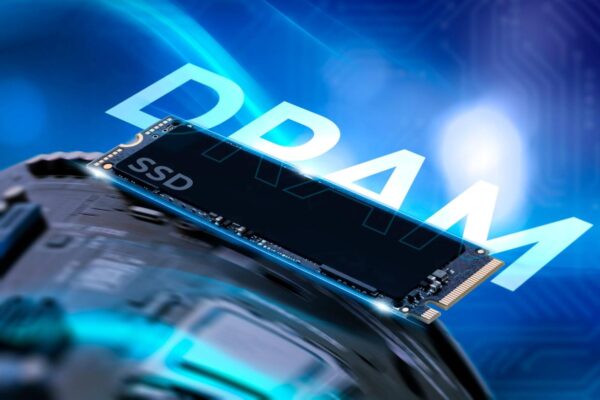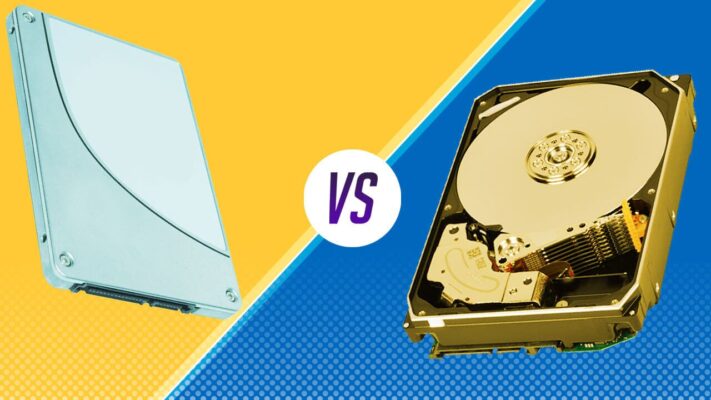You’ve probably heard the term “SSD” thrown around when talking about computers, especially when discussing speed and performance. But what is an SSD? This comprehensive guide will cover everything you need to know about Solid State Drives, from the basics to the advanced details.
What is an SSD?
A Solid State Drive (SSD) is a data storage device that uses flash memory to store data. Unlike traditional hard drives (HDDs), SSDs do not have moving parts. Instead, they rely on semiconductors, more specifically NAND flash memory, to store and retrieve data. This fundamental difference between HDDs and SSDs gives SSDs distinct advantages, including faster data access, improved durability, and reduced power consumption.
Flash memory is a type of non-volatile memory, which means it retains data even when the power is off. This makes SSDs a reliable and efficient storage solution for a wide variety of applications, from personal computing to enterprise-level storage needs.

Types of SSDs
There are several types of SSDs, each with unique features, performance levels, and use cases. These SSDs vary based on their interface, form factor, and underlying technology. Let’s break down the most common types of SSDs to help you understand which one suits your needs best.
1. SATA SSDs (Serial ATA)
SATA SSDs are the most common and affordable type of SSD. They use the SATA interface, the same one used by traditional hard drives. While SATA SSDs are faster than HDDs, they are limited by the speed of the SATA interface, which typically caps data transfer rates at around 600 MB/s.
SATA SSDs are ideal for upgrading older systems or for users on a budget who need a substantial speed boost over traditional hard drives. However, compared to other SSD types, their performance is slower.
Example: If you’re upgrading your laptop or desktop and want a noticeable boost in boot time and application launch speed without paying for the latest technology, a SATA SSD is a solid choice.
2. NVMe SSDs (Non-Volatile Memory Express)
NVMe SSDs provide the fastest data transfer speeds and are perfect for high-performance computing. They use the PCIe (Peripheral Component Interconnect Express) interface, which offers significantly higher bandwidth than SATA. NVMe SSDs can reach data transfer speeds of up to 7,000 MB/s, depending on the version and the number of PCIe lanes used.
NVMe SSDs are ideal for tasks that demand high-speed data access, such as gaming, video editing, and large-scale data processing. Their performance and speed are the main advantages over SATA SSDs, but they come at a higher price.
Example: If you’re building a gaming PC or working with video editing software, an NVMe SSD will provide faster load times and smoother performance.
3. M.2 SSDs
M.2 is a form factor, not a type of SSD itself. M.2 drives can use either the SATA or NVMe interface, so their performance depends on the interface they support. M.2 drives are compact and typically used in ultrabooks, laptops, and high-performance desktops.
If an M.2 drive uses the SATA interface, it will have similar performance to a regular SATA SSD. However, if it uses the NVMe interface, it will provide faster speeds, comparable to PCIe NVMe SSDs.
Example: For ultra-thin laptops or custom desktops, M.2 SSDs offer a great balance of size and performance. If you’re using it for gaming or high-speed computing, look for an M.2 NVMe drive for optimal performance.
Advantages of SSDs
SSDs offer numerous advantages over traditional hard drives, which is why they have become the storage solution of choice for modern computing. Here are some of the key benefits:
1. Faster Speed
The most noticeable advantage of SSDs is their speed. SSDs provide much faster read and write speeds compared to HDDs. This results in quicker boot times, faster file transfers, and improved system responsiveness.
For instance, booting up an operating system from an SSD can take mere seconds, whereas an HDD might take over a minute. This speed improvement is especially noticeable when running resource-heavy applications like video editing software or games.
2. Durability and Reliability
Since SSDs have no moving parts, they are more resistant to physical shock and vibrations compared to HDDs. This makes them ideal for portable devices, laptops, and mobile computing, where hard drives may be more susceptible to damage.
Moreover, SSDs generally have a longer lifespan than HDDs because there is no mechanical wear-and-tear.
3. Lower Power Consumption
SSDs consume less power than HDDs because they lack moving parts. This translates to longer battery life in laptops and mobile devices, making SSDs a preferred choice for portable devices.
4. Quiet Operation
SSDs operate silently because they don’t have spinning disks or moving heads. This is a significant advantage in noise-sensitive environments, such as office spaces or home theaters.
5. Smaller and Lighter Form Factor
Due to the absence of mechanical parts, SSDs are smaller and lighter than HDDs. This makes them more suitable for ultra-thin laptops and other compact devices.
Disadvantages of SSDs
While SSDs are superior in many ways, they do have a couple of drawbacks:
- Cost: Historically, SSDs have been significantly more expensive per gigabyte than HDDs. While prices have come down considerably, HDDs still offer a lower cost for large storage capacities.
- Capacity: While SSD capacities have increased, it’s still generally more expensive to get very large SSDs (e.g., 4TB and above) compared to HDDs. This is becoming less of an issue as technology advances.
- Write Endurance: Limited number of Write/Erase.
SSD vs HDD: Key Differences
Choosing between a Solid State Drive (SSD) and a Hard Disk Drive (HDD) is a fundamental decision when building or upgrading a computer. While both technologies serve the same basic purpose – storing your operating system, applications, and files – they differ dramatically in their underlying technology, performance, and cost. This section provides a detailed comparison to help you understand the trade-offs and make the right choice for your needs.

Technology:
- HDD (Hard Disk Drive): HDDs are mechanical devices. They store data on spinning magnetic platters. A read/write head, mounted on a moving actuator arm, accesses data by physically moving to the correct location on the platter. This mechanical process is inherently slower than electronic storage. Think of it like an old-fashioned record player.
- SSD (Solid State Drive): SSDs use flash memory (typically NAND flash) to store data electronically. There are no moving parts. Data is stored in memory cells, and the SSD controller can access any cell almost instantly. Think of it like a giant, super-fast USB flash drive.
Performance:
- Speed: This is the most significant difference. SSDs are drastically faster than HDDs in every aspect of performance:
- Boot Times: Computers with SSDs boot up much faster (often in seconds).
- Application Loading: Applications launch and load almost instantly on an SSD.
- File Transfers: Copying and moving files is significantly quicker on an SSD.
- Overall System Responsiveness: The entire system feels snappier and more responsive with an SSD.
- Latency: SSDs have much lower latency (the delay before a data transfer starts) than HDDs. This is because there’s no need to wait for a mechanical head to move to the correct location.
- Random Access: SSDs excel at random access (accessing data in non-sequential order), which is common in everyday computing tasks. HDDs are slower at random access because the read/write head has to move around the platter.
Durability and Reliability:
- HDD: HDDs are susceptible to damage from drops and shocks due to their moving parts. The read/write head can crash onto the platter, causing data loss or drive failure.
- SSD: SSDs are much more durable and resistant to physical shock because they have no moving parts. This makes them a better choice for laptops and other portable devices.
- Lifespan: While SSDs have a limited number of write/erase cycles, modern SSDs have very high endurance ratings, and wear-leveling algorithms distribute writes evenly across the drive. For most users, an SSD will likely outlast the useful life of their computer. HDD have lifespan too, because of motor and other mechanical parts.
Noise and Power Consumption:
- HDD: HDDs can produce noticeable noise (whirring, clicking) due to the spinning platters and moving read/write head.
- SSD: SSDs are completely silent.
- Power: SSDs consume significantly less power than HDDs, which can lead to longer battery life in laptops.
Cost and Capacity:
- HDD: HDDs offer a much lower cost per gigabyte than SSDs. This makes them a cost-effective option for storing large amounts of data (e.g., photos, videos, music).
- SSD: SSDs are more expensive per gigabyte, although prices have been steadily decreasing. While you can get large-capacity SSDs (e.g., 4TB, 8TB), they are significantly more expensive than HDDs of the same capacity.
How Does an SSD Work?
SSDs operate differently than traditional hard drives. Instead of using spinning disks (platters) and read/write heads, SSDs store data on memory chips made up of flash memory cells. These cells are organized into pages and blocks.
When data is written to an SSD, it is placed in empty memory cells. The process of reading data from the SSD is much faster because it doesn’t involve moving parts or waiting for a spinning disk to align with the read/write head. This results in faster access times, which is why SSDs are widely used to boost the performance of modern computers and devices.
Key Components of an SSD:
- NAND Flash Memory: The primary storage medium in an SSD, composed of memory cells that hold data. These cells are grouped into pages and blocks.
- Controller: The controller is the brain of the SSD, managing how data is read from and written to the NAND flash memory. It also handles functions like wear leveling and garbage collection to ensure optimal performance.
- Cache: Some SSDs include a cache, often made of DRAM, which acts as a temporary storage area to speed up data access and improve overall performance.
- Interface: SSDs use interfaces like SATA (Serial ATA), PCIe (Peripheral Component Interconnect Express), and NVMe (Non-Volatile Memory Express) to communicate with the computer or device. NVMe and PCIe SSDs offer faster data transfer speeds compared to SATA SSDs.
In conclusion, Solid State Drives (SSDs) have revolutionized the storage industry by offering faster speeds, better durability, and improved efficiency compared to traditional HDDs. While they come at a higher price point, the benefits they provide in terms of performance and reliability make them an excellent investment for most users. Whether you’re upgrading your personal computer, building a high-performance gaming system, or setting up enterprise storage, SSDs are the go-to storage solution for modern computing needs.
